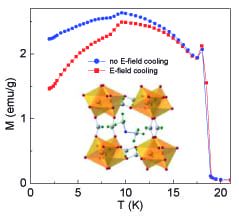The possibility of controlling the magnetization of a material with an electric field or, conversely, the control of electric polarization with a magnetic field, has enormous potential in a wide range of applications such as information storage, sensing and actuation, electrically tunable microwave devices, and spintronics. Recent results of Young Sun and co-workers at the Chinese Academy of Sciences published in physica status solidi (RRL) show for the first time that such control is possible in certain networks of metal ions connected by coordinating organic linkers known as metal-organic frameworks (MOFs).
 The coexistence of magnetic and electric order in the same material – multiferroism – shows promising applications by itself but is a rare phenomenon in single-phase materials. A few years ago, multiferroism was observed for the first time in some MOFs, opening a new route to multiferroics beyond inorganic materials. However, the cross coupling of magnetic and electric orders, the so-called magnetoelectric effect, is more interesting for practical applications than the mere coexistence of both kind of orders and has not been observed until now in the multiferroic state of MOFs. In them, magnetic and electric orders usually have separate origins and therefore are not expected to be strongly coupled. The work of Young Sun and coworkers demonstrates for the first time electric field control of magnetism – converse magnetoelectric effect – for a multiferroic MOF.
The coexistence of magnetic and electric order in the same material – multiferroism – shows promising applications by itself but is a rare phenomenon in single-phase materials. A few years ago, multiferroism was observed for the first time in some MOFs, opening a new route to multiferroics beyond inorganic materials. However, the cross coupling of magnetic and electric orders, the so-called magnetoelectric effect, is more interesting for practical applications than the mere coexistence of both kind of orders and has not been observed until now in the multiferroic state of MOFs. In them, magnetic and electric orders usually have separate origins and therefore are not expected to be strongly coupled. The work of Young Sun and coworkers demonstrates for the first time electric field control of magnetism – converse magnetoelectric effect – for a multiferroic MOF.
Young Sun’s team considered a Fe-based MOF single crystal, [(CH3)2NH2]Fe(HCOO)3, and showed that applying a moderate electric field of a few kV/cm during the cooling process causes a pronounced change in the magnetization of the MOF’s low temperature multiferroic state. “The physical mechanism of this magnetoelectric effect,” explains Young Sun, “is distinct from those known in inorganic multiferroics.” Its origin is the manipulation of the hydrogen bonds in this material by the applied electric field, which modifies the exchange interaction between Fe+2 ions. “In principle,” Young Sun concludes, ”this new approach to electric field control of magnetism can be applied to many other organic magnets containing hydrogen bonds.”

















